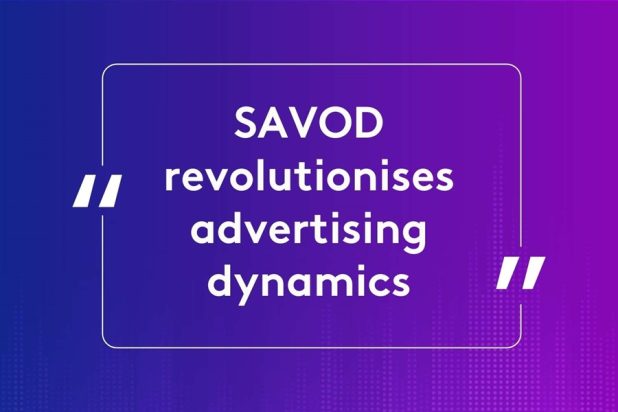Poised to transform viewer experiences and revolutionise the advertising world – Subscription Advertising Video On Demand (SAVOD) offers a range of expanded choices, improved ad experiences – and marks a major strategic shift among streaming powerhouses
Subscription Advertising Video On Demand (SAVOD): Revolutionising viewer experiences and advertising dynamics

Subscription Advertising Video On Demand (SAVOD), both native and broadcaster-driven, has proven itself as a highly flexible and cost-effective option for advertisers over the last year. Simultaneously – and as part of a hybrid monetisation strategy – it has also emerged as a lucrative new revenue stream for both platforms and networks.
According to Digital TV research, global AVOD revenue is now forecast to reach $91bn by 2028, more than double the $41bn it recouped in 2022. It is also expected to grow nearly twice as much as subscription VOD (SVOD).
The consumer base for SAVOD is also witnessing a significant expansion. This growth is fueled by the strategic shift of traditionally subscription-only giants such as Netflix, Disney+, and, more recently , Amazon Prime – which turned ads on as a default for its tens of millions of users. It’s a move for the latter that could, according to a recent Hollywood Reporter article, “unravel how advertisers deal with TV broadcasters and scare off rivals with its massive scale.”
That remains to be seen, but what we can be absolutely sure about is that by diversifying their models, the streaming platforms are unlocking vast new opportunities while overcoming longstanding challenges like ad-blocking by integrating advertisements directly into the content stream, creating a more cohesive viewing experience. Yet, perhaps more than anything, AVOD’s main draw is the ability to target audiences accurately, enhancing both the impact and efficiency of advertising spend.
Viewer impact
That’s a snapshot of what it means for the industry side, but looking ahead, what will the growth of SAVOD mean for viewers this year, and how might that impact viewing behaviours?
The foremost change will almost certainly be the expanded array of choices and new lower cost basic packages – a particularly appealing prospect for those dealing with subscription fatigue or enduring impact of the cost of living crisis. SAVOD is thus poised to become a haven for cost-conscious viewers, offering access to popular content at a fraction of the price of multiple SVOD subscriptions.
Indeed, the latest data from the 2024 issue of Kantar Media’s TGI Global Quick View study shows that 59% of video on demand users globally “would be happy to put up with adverts if my TV / video streaming subscription was cheaper.” This rises to more than three-quarters of consumers in Nigeria and India, while fewer than 30% agree in Norway, Denmark & Sweden – suggesting that the roll-out of AVOD strategies should be nuanced according to the dynamics of the local market.
AVOD – subscription or otherwise – is also anticipated to usher in an era of enhanced ad experiences. Advertisers, aiming to maximise their reach and target ads more effectively, could lead to a more refined and less intrusive ad experience for viewers. This evolution could significantly enhance the overall viewing experience.
Meanwhile, the competition for viewer attention is likely to spur innovation in ad formats. As noted in our most recent Media Trends and Predictions report, we might witness a surge in interactive ads, creative storytelling within advertisements, and shorter ad breaks, all aimed at improving viewer engagement and satisfaction.
The changes SAVOD brings are not confined to advertising alone; they extend to how content is accessed and consumed. Here, however, one potential downside is that not all content may be available on SAVOD tiers, with some platforms possibly reserving their original or premium content for full-paying subscribers. This could lead to a shift in access and viewing habits. Additionally, viewers accustomed to ad-free streaming will need to adjust to the presence of advertisements, which could interrupt the flow of viewing and disrupt immersion in the content.
Data privacy issues are also likely to come to the forefront, as increased ad targeting might lead to apprehensions about data collection and usage. Users will need to navigate these concerns, making informed decisions about their privacy settings and data sharing preferences. Furthermore, as the advertising landscape continues to evolve, so too will the regulations governing AVOD advertising. This could impact the types of ads viewers are exposed to and their overall user experience.
Finally, the capabilities of AVOD are set to expand significantly in 2024. AVOD platforms are already experimenting with different engagement forms, such as product placement and interactive ads, some even offering shoppable functions. This further blurs the lines between content and commerce in the video marketplace, and potentially heralds a new era for advertising.
The measurement picture
As SAVOD growth accelerates, the role of cross-platform audience measurement will also become more integral, particularly for platforms and networks that need to know how to accurately adjust their hybrid monetisation strategies.
As competition for both viewer attention and advertising spend becomes fiercer, there will be an increasing need to comprehend the whole market, not just areas previously explored or surveyed. In markets such as Brazil and more recently Spain, Kantar Media has made this view available publicly, providing a monthly up-to -date and accurate picture of the viewing landscape and audience behaviour. The data is extracted from Cross-Platform ViewTM, a solution which places different forms of viewing in context and allows like-for-like comparisons of time spent.
While first-party data remains valuable, it provides a limited perspective when used in isolation. For a comprehensive understanding of the market dynamics and appropriate strategic responses, it’s essential to integrate first-party data with extensive third-party data. This approach will enable businesses to gain a more complete understanding of the competitive landscape that will shape future viewing experiences.